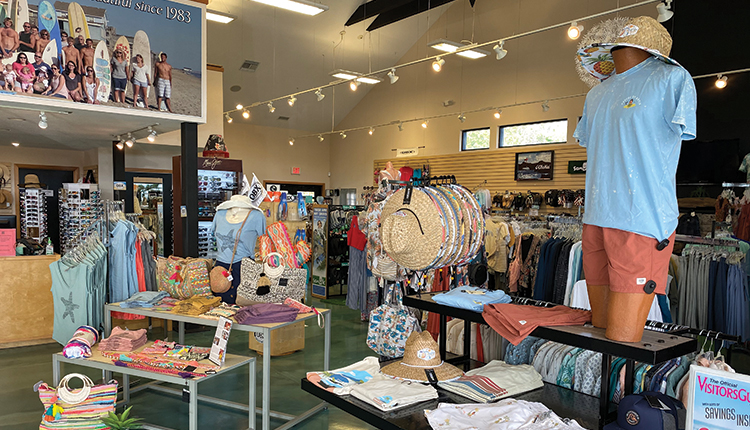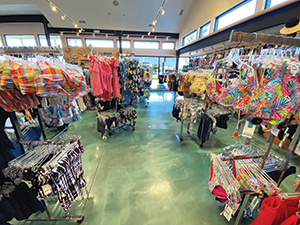Buying strategies for unpredictable times |
| By Shane Sharp |
Keeping your store freshly stocked with merchandise in the New Year is a challenging puzzle to solve. If 2020 wasn’t isolating enough with the proliferation of the COVID-19 pandemic, Stuart Joblin, longtime owner of Makin’ Waves on Bermuda, found himself on a literal and figurative island. In a typical year, he and co-owner Doug Patterson would make several trips to U.S. fashion hot spots to gather an eclectic mix of fun, fashionable lines for the iconic surf shop they opened back in 1988. When the island’s air and sea ports shut down last March due to the coronavirus, the childhood friends knew they’d be grounded for an extended period of time. “We usually make a couple trips to south Florida every year to attend smaller rep seasonal shows, but we couldn’t even do that this year,” Joblin says. “We do about 75% of the purchasing for our store from the lines we see at shows.” Bermuda’s L.F. Wade International Airport reopened mid-summer 2020, however, the continuation of strict travel restrictions to and from the island, and uncertainty surrounding the year ahead, forced the partners to reconsider their buying strategy for 2021. “For 2021 it [our strategy] seems to be all about survival,” Joblin says. “We are keeping a close watch on sales and stock levels to keep inventory at a ‘just in time’ delivery level. It’s challenging to form a firm plan. By staying on top of stock, managing expenses and payables, we hope to be ready for the recovery when it happens.” Cautious optimismIf there’s a common theme among shop owners and buyer reps in what everyone hopes is a big bounce-back year, it’s cautiously optimistic buying strategies that are deployed with a healthy dose of risk management. Jayne Forrestt, owner of The Coral Crab, a manufacturers’ representative group in Old Saybrook, Connecticut, is confident about the recovery of the boutique retail market this year. She encourages her clients to plan for best-case scenarios, but to be deliberate in formulating their buying strategies. “It’s always important to take some risks when buying,” Forrestt says. “During COVID-19, those risks should be more calculated, and you should have supporting data from other retailers and reps. Social media is also helpful for researching trends and gathering real-time information.” Buyers’ risk level could decrease toward the end of the year, according to Forrestt, when there is more clarity about availability of a COVID-19 vaccine and less threat of state and local lockdowns. “For those people who have truly been staying at home and not seeing loved ones, there will be a reason to celebrate when this is all behind us,” she says. “Indications point to a pendulum swing and people really living it up, being grateful and making up for lost time.” That pendulum began to swing, in full, in North Carolina’s famed Outer Banks during the summer of 2020. From Corolla south to Ocracoke, the iconic destination experienced strong tourism numbers after it reopened in May and was on pace to log a record number of visitors during its fall shoulder season. Jill Bennett, owner of Birthday Suits, a regional chain of boutique surf shops, was well-positioned to ride the fall wave with stores in Corolla, Duck and Kill Devil Hills. People converting extended overseas vacations into weekend getaways, coupled with those who’d grown tired of shopping online, created strong sales at all three locations. “Beach retail in 2020 was surprisingly good because people weren’t flying overseas, and they were driving in droves to the beach,” Bennett says. “But in 2021 if we have a vaccine, or if COVID-19 is behind us, that could all change. Or if the pandemic worsens we could be locked down again. So at this point we are taking a conservative but optimistic approach to our buying and monitoring the situation as it evolves.” Trade show approachBirthday Suits relies heavily on Surf Expo in Orlando, Florida, and Swim Collective, in Anaheim, California. Both shows have January events, only this year Swim Collective canceled its January show. The two shows normally account for about 60% of the chain’s total buy.  Birthday Suits in the Outer Banks had a busy 2020 season as people took more trips by car than by air. “The other 40% is done face to face with our sales reps at home,” Bennett says. Birthdays Suits had to rely on virtual shows and meetings in 2020, but Bennett is counting on in-person shows to play a major role in her buying strategy this year, especially when it comes to getting ahead of trends. “At Surf Expo we set up appointments ahead of time with our current vendors then allow at least a half day to walk the entire show to search for new products and vendors.” Joblin and Patterson set up meetings with reps from their established brands weeks in advance for Surf Expo. A few weeks out, they’ll visit the show website for new brands they want to check out that week. “We always walk the entire show on the first day, paying special attention to any new vendors,” Joblin says. “We take notes and compare after the show to see who noticed what and then plan to revisit the booths before the show ends.” While walking and exploring may sound like the antithesis of strategic thinking, time set aside for new discoveries is time well spent at trade shows, according to Kathy Wilkie, senior buyer relations manager for Surf Expo. “In my opinion it is vital to keep your shelves fresh, which means bringing in new products,” Wilkie says. “Don’t take huge risks and put all of your buy-in into something you haven’t bought before, but try a few new products, lines and brands. This keeps the customers coming back because they want to see what’s new in your store.” Seasonal swingsFor many retailers and reps, the traditional peak, shoulder and off seasons were skewed in 2020 with the abrupt stoppage of travel in March and April. In addition to the Outer Banks, other drive market destinations experienced a tourism boom well into fall when retail business historically grinds to a halt. Beth Garcia, a manufacturers’ sales rep for Lake Shirts/Blue84, MV Sport, Tommy’s Designs and Kid U Not, expects 2021 will revert to some semblance of normalcy. She spent 12 years as a retail buyer for Salty Sam’s Marina in Fort Myers, Florida, before switching to the manufacturing side of the buying equation. “Be stocked for the [peak] season, keep your stores clean and well-merchandised, and train staff to be knowledgeable about the products you are selling,” she advises retailers. “You have more room for different product types and price points in-season. In the off-season you may lower your price points, lighten inventory, run sales on lingering merchandise and assort products to cater to locals.” Staggering order shipments during the peak season is a cost-effective tactic for keeping new product coming in on a weekly basis, according to Kim Bartolotta, founder and owner of Elevation in Deep River, Connecticut. Bartolotta and her reps focus on introducing new female artisans to the gift industry. “I think for the off-season, they should be careful and be sure to always bring in new and fresh [product] but in smaller quantities,” she says. “During the peak seasons, you should always plan ahead and buy enough product to keep your store looking full. Stick with the best sellers but always have something new in the mix.” Avoiding mistakesA successful buying strategy entails optimizing inventory, maximizing margins and mitigating risk. And national trade shows, regional rep shows, magazines and catalogs, websites and social media research are key for discovering new lines that will trend in the year ahead. But a winning formula also comes down to avoiding classic pitfalls that snare retail buyers year-after-year. “Hands-down, the number one issue I see is a shop not bringing in enough product,” Bartolotta says. “If you don’t end the season with 10% left over, you didn’t buy enough. Too often stores try something new with just a few pieces, without making a proper statement.” Garcia says two common mistakes shop owners make are both rooted in being too insular. First, they buy or over-order product lines they like personally. Second, they don’t spend enough time on the sales floor with their customers to get a qualitative finger on the pulse of the retail market. “There are some things you just can’t get from reports and numbers,” Garcia says. “You have to remove your ego from the process.” And while it sounds like a box every retailer should be checking, she’s encountered numerous shop owners who don’t take time to meaningfully evaluate a product line’s impact on the bottom line. “Being proactive allows some room for testing products,” Garcia says. “Try a smaller quantity, watch it begin to sell and then invest in larger quantities and receive quantity discounts. Too much of a bad product is too much, and testing is important. There are minimums with lines for a reason.” Order ample product for the peak season, be objective in selecting new lines and be proactive — all easy to follow strategic counsel. Oftentimes, though, it’s hard for shop owners to take a step back from the rigors of running their own business. According to Wilkie, outside sales representatives can be true partners in creating and executing buying strategies. “Good brand reps can be vital to the success of a retail business,” she says. “They can tell you the trends they are seeing so you get in on what’s coming, rather than the trend that just ended. They can help differentiate your shop from the one next door by not selling you both the same things. And lastly, a good rep can let you know when the brand may be offering an upcoming promotion that can help save you money on the inventory you need.” |
